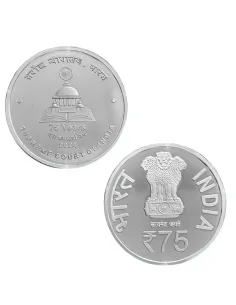
- Online only
Buy Limited Edition 250 Rupees India Govt. Mint 250th Birth Anniversary Of Raja Ram Mohan Roy Commemorative Coin (Rs.250 Coin)
250 Rupees India Govt. Mint 250th Birth Anniversary Of Raja Ram Mohan Roy Commemorative Coin (Rs.250 Coin)
Commemorative Coins :
manufacturing circulation coins. These coins are issued to commemorate events of historical
and social importance and to celebrate various accomplishments of public and private
organizations. India Government Mint, Mumbai has been releasing commemorative coins since
1964. The commemorative coins issued by the Mint are of very high quality and have a great
demand among coin collectors and numismatists.
Commemorative coins are of two types
Proof Coins
Uncirculated Coins
Proof Coins:
Proof coins are the high quality commemorative coins which have a frozen effect on the surface
design of the coin with a mirror finish. These coins are marked with the symbol 'M' to indicate
that they are manufactured at Mumbai Mint. These coins are sold at a premium price as they
are manufactured with high quality standards and have high numismatic value.
Uncirculated Coins:
Uncirculated coins are the high quality commemorative coins which have mirror finish on the
surface but without any frozen effect on the design. These coins are marked with a diamond
symbol to indicate they are stamped at Mumbai Mint. The uncirculated coins are also sold at
premium but they are priced a little lower than the proof coins.
History
In 1964 production of commemorative coins was started. The first commemorative coin was in the memory of Pandit Jawaharlal Nehru.
Theme Description
Ram Mohan Roy (22 May 1772 – 27 September 1833) was born in Radhanagar, Hooghly District, Bengal Presidency. His great grandfather Krishnakanta Bandyopadhyay was a Rarhi Kulin Brahmin. Among Kulin Brahmins – descendants of the six families of Brahmins imported from Kannauj by Ballal Sen in the 12th century – those from the Rarhi district of West Bengal were notorious in the 19th century for living off dowries by marrying several women. Kulinism was a synonym for polygamy and the dowry system, both of which Rammohan campaigned against. His father, Ramkanta, was a Vaishnavite, while his mother, Tarini Devi, was from a Shaivite family. He was a great scholar of Sanskrit, Persian and English languages and also knew Arabic, Latin and Greek. One parent prepared him for the occupation of a scholar, the Shastri, while the other secured for him all the worldly advantages needed to launch a career in the laukik or worldly sphere of public administration. Torn between these two parental ideals from early childhood, Ram Mohan vacillated between the two for the rest of his life.
He was given the title of Raja by Akbar II, the Mughal emperor. His influence was apparent in the fields of politics, public administration, education and religion. He was known for his efforts to abolish the practices of sati and child marriage. Roy is considered to be the “Father of the Bengal Renaissance” by many historians.
| Denomination of Coin | Shape and outside diameter | Standard Weight | Number of serrations | Metal composition |
| Rs. 250 | Circular
44 mm |
35 Grams | 200 | Quaternary Alloy
Silver – 50% Copper – 40% Nickel – 05% Zinc – 05% |